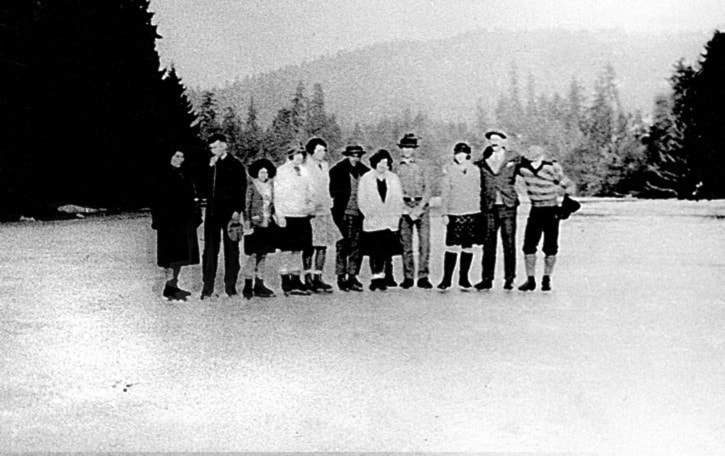HELGESEN SKATING PARTY, 1920s
Long before All Sooke Day was first held at the Sooke Flats, the low-lying riverside land between Phillips Road and the Sooke River was used for summertime gatherings. This 1920s scene shows it was popular in the winter as well, when the lower temperatures of those years meant skating on the Sooke River.
While the block of land reaching from the mouth of the Sooke River west to Solent Street and northerly to the Phillips farm was held then by the Charters family, local folk knew they were welcome to enjoy the Flats in the neighbourly spirit of the day.
This scene shows the river at its widest expanse just before the bend where it is joined by DeMamiel Stream. Christian and Haldis Helgesen are seen skating with two of their children, Irene and Harry, along with friends that included Rupert Soule and Harry George.
In those days, more water came down the river from Sooke Lake and the watershed than is the norm today. The fresh water tended to flow out above the salt water, as it joined with the salt from the harbour. Doug MacFarlane, whose family has lived upriver adjacent to the bridge since 1948, recalls watching the action of the ice at the shoreline due to the ebb and flow of the tide. The ice surface that had frozen at high tide, would collapse when the tide ebbed, creating splintering and cracking at the edge as the ice lowered with the receding water.
Chatting with residents living further up the river not far from the Sooke Potholes and the Sooke River falls, we learn that winters as recent as 1970 sometimes allowed skating on river ice. Mary Day recalls that the temperature was 14 degrees below zero Fahrenheit when she and Eric and their son Phillip skated alongside their river front home during a couple of winters, 1969 and ‘70.
Elida Peers
Historian, Sooke Region Museum
